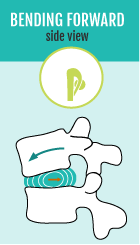When we hear about ‘Disc Herniation’ we usually associate such a thing with the lower back or lumbar spine, a common mechanism has been shown in clinical studies to be flexion of the lumbar spine (repeated or prolonged) and also some degree of twisting although this alone is not thought to be as damaging as flexion. Stuart McGill, Ph.D., author of the book “Low Back Disorders,” concluded that repeated or prolonged spine flexion is the primary mechanism leading to lumbar disc herniation.
The discs themselves act as ‘shock absorbers’ between the vertebrae and are made up of outer fibres (annulus fibrosis) which is dense tough connective tissue almost ligament like in its make up and a jelly like centre which provides some spring (nucleus pulposis) which is well hydrated and allows shock absorption throughout the spine. A herniation of the discs usually results from damage to the outer fibres of the disc and subsequent ‘bulging’ of the nucleus pulposis, which is referred to by many names; slipped disc, bulging disc, herniation, prolapse all depending on the degree of damage (As seen below)

The disc on the left is healthy with no damage to the outer fibres allowing the centre (nucleus pulposis) to stay central and provide good support to the vertebra above and below the joint. The centre disc is showing early signs of outer fibre damage and as we can see this allows the nucleus to ‘bulge’ outward toward the spinal cord and nerve roots. The disc on the right is showing a complete herniation or prolapse of the nucleus through the annulus fibres which have been catastrophically damaged, this results in spinal nerve root and central cord stenosis which can present with extreme pain locally and radiation or referral, most commonly down the legs.
Now that we have an understanding of the disc and what it does we can look at how the damage seen above can and usually does occur. Physics determines that when we move our spine the disc (due to its spongy make up) moves in between the vertebra and for the sake of this article we are going to have a look at the effect flexion of the spine has upon the disc.
 We can see that when the spine is placed into flexion the nucleus of the disc if forced backward, toward the spinal cord, if we look back it was concluded that repeated or prolonged spine flexion is the primary mechanism leading to lumbar disc herniation. So if we apply this to exercises such as the squat and the deadlift we are placing an even greater load upon the spine and the discs with the added resistance, which results in a greater force upon the nucleus and a more detrimental effect on the outer fibres of the disc, which can result in a failure of these structures leading to possible herniation or protrusion of the disc.
We can see that when the spine is placed into flexion the nucleus of the disc if forced backward, toward the spinal cord, if we look back it was concluded that repeated or prolonged spine flexion is the primary mechanism leading to lumbar disc herniation. So if we apply this to exercises such as the squat and the deadlift we are placing an even greater load upon the spine and the discs with the added resistance, which results in a greater force upon the nucleus and a more detrimental effect on the outer fibres of the disc, which can result in a failure of these structures leading to possible herniation or protrusion of the disc.
It is fairly common to see people perform a squat (at the base of the squat) or deadlift (during the initial phase of the lift) with some degree of lumbar flexion or reverse of the normal curve, if this is occurring every time the exercise is performed we are exposing our lumbar spine and discs to an extremely forceful and repetitive damaging stimulus, which can and most likely will result in either the centre disc as seen above or even worse the disc on the right.
It is extremely important to note that when we are squatting or deadlifting that to reduce injuries, proper form should be stressed before increasing weight loads!! Physical restrictions whether it be joint restriction, muscular restriction or a biomechanical issue may affect the way in which you can perform a squat/deadlift or any other exercise for that matter, need to be addressed before you can squat as deep as you want to or perform a perfect deadlift.
If you find that you flex your lower back when you squat or deadlift firstly; lower the weight and see if there is any improvement and secondly; get assessed by your chiro or physio to check for any physical limitations your body may need addressed before you are able to progress with the exercise!
Take Home Tips:
- When performing any exercise aim to maintain the normal curve in your spine
- Stress proper form over increase in weight to reduce risk of injury
- Get checked out to make sure you aren’t putting yourself at risk of injury and possibly address some of the reasons why your are flexing the lower back (of which there are many!!)
- Following these tips you will probably find your lower back isn’t aching after a workout and in the long run you wont run into any more serious injuries!
As always if you have any further questions or concerns contact Synergy Healthcare on 02 9522 2125 or via email clinic@synergyhealth.com.au and we will be more than happy to help you out!!
